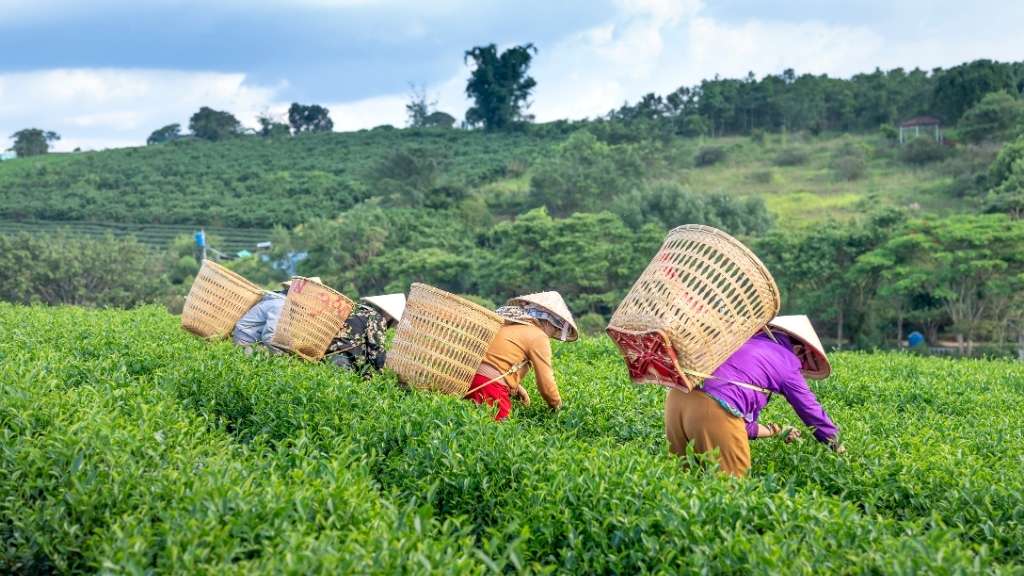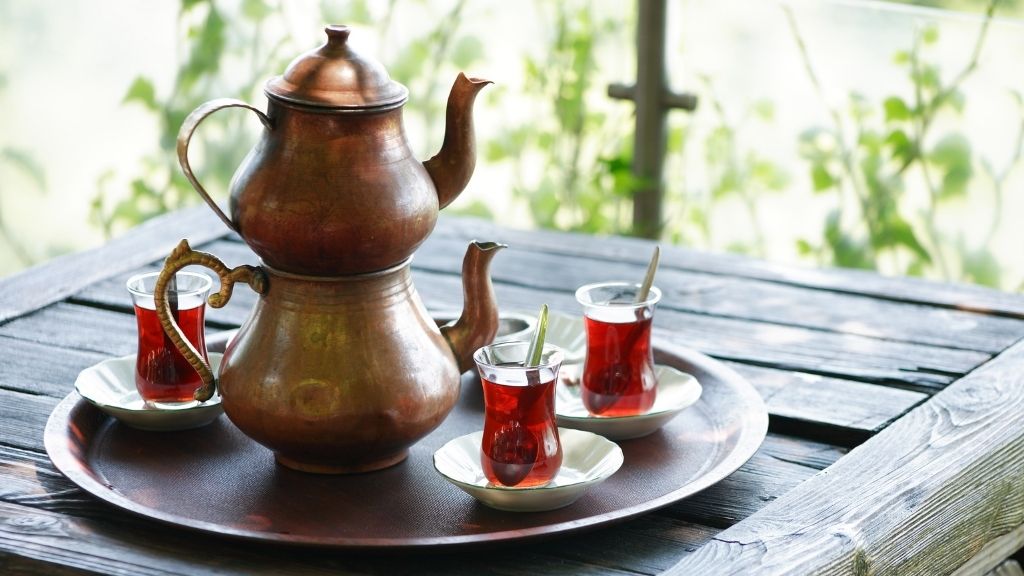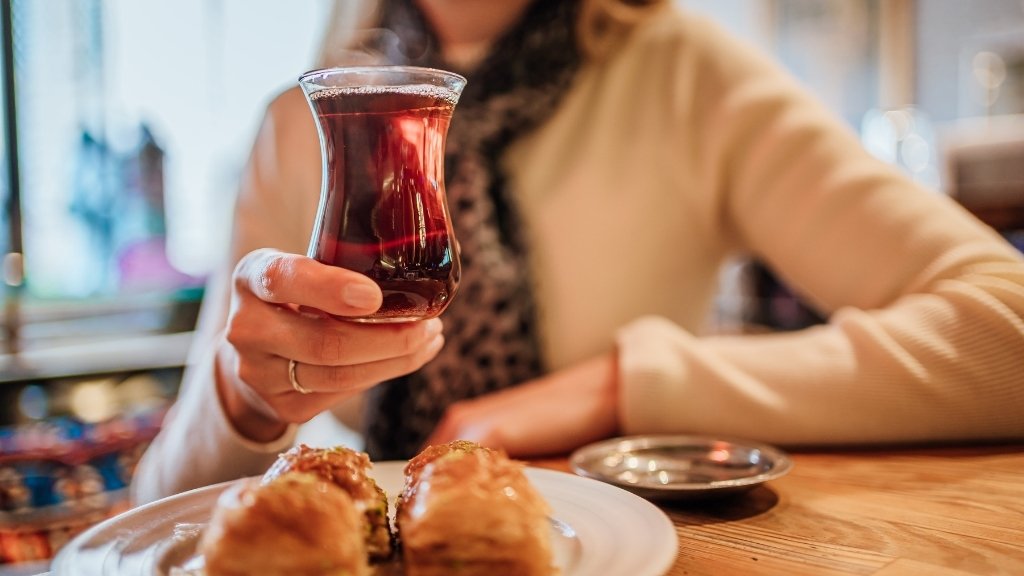Have you ever noticed how Turkish tea is always poured into fragile glasses in the shape of a tulip, and a piece of warm conversation usually accompanies it? 🍵 It is not only about the drink, but it is about connection, daily routine, and common experiences. In the big cities, the small towns, the bazaars, and even small villages, tea is not only popular, it is part of the national rhythm.
This daring black tea is also called “cay ” locally, and it has a special place in Turkish culture. In this article, we are going to go into its rich history, find out what it is composed of, how it tastes, and why it is so loved, not only in Turkey but also in other parts of the world. So, what makes this simple brew so special? Let us examine that a little more closely.
A Personal Moment with Turkish Tea
I can still recall my first Turkish Tea in a glowing tulip glass, in a misty teahouse high in Rize, looking down on the Black Sea. One local resident gave me a large glass of it with a big smile. The taste was something I would never forget: strong, earthy, and very comforting, like the hospitality I had grown to love in Turkey. And that one cup was a silent ceremony of my ten years of residence there–a cup drunk in profound conversation with friends or in contemplating the setting sun behind the Bosphorus.
Türkçe: “Çaysız sohbet, aysız gök yüzü gibidir”.
“Conversations without tea are like a night sky without the moon.”
To me, Turkish Tea was not a drink but a peaceful daily moment that I shared with others.
What is Turkish Tea?
Turkish tea is a strong black tea mainly produced in the green province of Rize, situated along the Black Sea coast of Turkey. The process is carried out in an ancient style with a double teapot known as a çaydanlık. It is served hot in clear tulip-shaped glasses, which emphasize its distinctive deep red color. It is distinctive because of its strong taste, which can be consumed without milk or lemon, and its accompaniment throughout the day, as it is drunk in the morning and also late at night when people talk.
In contrast to English or Chinese tea, Turkish tea is made stronger, and it should be drunk slowly in the company of people. It is not a beverage but a ceremony of kindness and friendship, which is the core of Turkish culture. While traditional Turkish tea holds a strong and earthy profile, fruit-based variations like Turkish Apple Tea have also become popular, especially among tourists seeking a sweeter and more aromatic experience of Turkish hospitality. It is earthy to take a break to have tea in a world that is in a rush- here, a glass of çay allows you to be slow and be together.
The History of Turkish Tea: A Historical Brew
The history of Turkish tea started to pick up speed in the early 20th century when the Turkish government was looking to find an easier alternative to coffee, as the cost was rising. The environment was not suitable for growing coffee. Although coffee had already been considered culturally superior, tea became the national drink due to its lower prices and the climate’s versatility in the Black Sea region of Turkey. The change did not happen overnight, but over time, tea got entrenched in the lives of the Turks.
Tea culture was initiated in ancient trade with China and appeared in the Ottoman Empire, where it was valued but not very popular yet. Tea only gained roots when the Republic was formed. The rich soil and humid climate in the coastal city of Rize made it perfect for growing Camellia sinensis, the plant that produces black tea.

Tea pickers harvesting fresh black tea leaves in the lush green fields of Rize, Turkey — the heartland of authentic Turkish tea production.
Rize is still the centre of Turkish tea production today, which makes up its history and future.
What Is Turkish Tea Made Of?
Turkish tea is produced using pure black tea leaves that are obtained using the Camellia sinensis plant, and no flavoring has been added or artificial boosters. The only difference is that it is simple, just well-dried leaves and water. These tea leaves are naturally processed to keep their original character and strong taste, and they are grown mostly in the green hills of Rize. There is nothing like fruit mixes or aromatic infusions here, but only the original, natural flavor of Turkish black tea.
Local Harvesting: The Tea Heritage of Rize and Quality Control
Turkey grows more than 200,000 tons of tea annually, and a massive portion of it is grown by local farmers in the Black Sea area. The leaves are carefully harvested when they are well mature and sorted, and dried in small-scale and regional factories that observe strict quality standards. Such local harvesting not only helps the communities of the region but also preserves the tradition.
The Traditional Turkish Tea-Making Process: çaydanlık Method
It is brewed in a traditional çaydanlık, a teapot stacked in two in almost every kitchen in Turkey. Water is boiled in the bottom pot, and the loose tea leaves are lightly steamed in the top pot, producing a rich, concentrated tea. To drink, this concentrate is mixed with hot water to individual taste, strong (demli) or light (açık), but never without flavor.
Want a complete brewing tutorial with ratios, serving tips, and insider techniques? Check out our detailed guide on how to make Turkish tea like locals do for an authentic, hands-on experience.

Traditional Turkish çaydanlık with steaming black tea in tulip glasses served outdoors — showcasing authentic Turkish tea brewing and serving ritual.
If you’re curious to dive deeper into the story, brewing rituals, and surprising health benefits of Turkish Black Tea, explore our complete guide for a more immersive look at this iconic drink rooted in culture and connection.
What Does Turkish Tea Taste Like?
The Turkish tea has a strong and mildly bitter taste with warm, earthy notes. As opposed to English blends, it is traditionally consumed without milk in order to bring out the natural richness of the black tea. The flavor is earthy and refreshing, an ideal partner to have with you all day long, in a moment of silence and in a raft of a chat.
The Turkish tea is so beautiful because it is versatile. You can enjoy it demli (strong), using more tea and less water, or açık (light), where it’s diluted with more hot water. I have discovered that the locals tend to leave the choice of brew to the mood or time of the day, stronger during the morning and lighter during the afternoon. When sugar is provided (most often in cubes), it is completely optional and not added automatically, but carefully set next to the glass so that you can add it yourself.
What Is Turkish Tea Good For?
Turkish tea is a mild, hydrating drink that is full of natural antioxidants, in addition to being a warm drink. It is less hard on the nerves than coffee due to its low level of caffeine, but it still gives a slight boost to the metabolism. A cup after a meal is also enjoyed by many people, as this can help the digestion process and prevent you from feeling the jitters.
In addition to the benefits of Turkish tea, it also carries a strong social and cultural influence. A glass of tea is the first greeting when you visit a home, when you sit in a shop, and even when you are waiting in a government office. It unites people, initiates talks, and makes moments of genuine interaction. It is just a matter of moderation.
Although the caffeine levels are low, consuming too much of it can affect iron absorption, particularly in individuals with dietary restrictive conditions.
How to Serve and Drink Turkish Tea
Turkish Tea is served as an art that shows the hospitality of the culture. It is conventionally served in small tulip glasses, which allow it to demonstrate the rich color of tea and to keep it hot, only to have time to drink it. It has a lovely rhythm, and friends will sometimes lightly clink glasses as they look into each other’s eyes. It is a subtle but very strong sign of respect and bonding that says more than words.
When and where to have it, Turkish tea is everywhere. Be it a bargain at the bazaar, a rest in a seaside cafe or a visit to someone’s house, a glass of tea is practically always a part of the occasion. It’s often paired with beloved local treats like simit, baklava, or börek, making it both a comfort drink and a shared experience. Wherever they are, tea is not a drink in Turkey; tea is a lifestyle to slow down and enjoy life.

I am enjoying traditional Turkish tea with baklava at a cozy Istanbul café, highlighting the cultural ritual and taste of authentic Turkish black tea.
Turkish Tea Around the World
Turkish Tea affection has spread to a great distance beyond the Turkish borders. It is a common comfort today in homes and cafes all over Europe, the Middle East, and North America, particularly in the Turkish communities who are happy to preserve the tradition. I have tasted it at cultural festivals, small local stores, and even teahouses in cities, and every cup tastes like home.
Turkish tea is special in the world because of the way it is prepared. It is not made with milk as in the creamy mixtures of the British or Indian teas, but is made in a double teapot or çaydanlık. This technique brings out a better, more robust flavor that does not need sugar or cream, just bold, clear tea in a glass. That audacity of simplicity remains to woo the hearts of people all over the globe, just as it continues to deepen its role in daily Turkish life.
Where to Buy Authentic Turkish Tea
It has never been simpler to obtain genuine Turkish tea, as more and more specialty shops and online retailers sell high-quality Rize tea leaves, the very type that is popular in Turkey due to its rich flavor and aroma. Now you can order a high-quality loose-leaf tea wherever you are, in New York, Berlin, or Dubai, and enjoy the real Turkish experience back at home.
To finish the ceremony, numerous stores sell the famous çaydanlık, the two teapots used to make it in the traditional method. I normally advise seeking out reliable Turkish groceries or specialized online retailers specializing in stocking products of Turkish origin. It is a little spend that goes a long way in terms of flavor and customization.
Frequently Asked Questions
What is Turkish tea made of?
Turkish tea is prepared using only black tea leaves, which are most often grown in the rainy area of Rize along the northeast coast of Turkey. These leaves are considered to be boldly flavored and dark red when well brewed.
How do you brew Turkish tea traditionally?
It is made in a 2-tiered teapot called a çaydanlık. The upper pot contains a strong tea concentrate, and the bottom keeps the water hot. You add hot water to the concentrate to make it to your own strength to serve.
Is Turkish tea caffeinated?
Yes, Turkish tea has caffeine, but not as much as coffee. It provides gentle energy pick-up without the jittery feeling that others experience with espresso or heavy brews.
What are the benefits of Turkish tea?
It contains a lot of antioxidants, aids in hydration, and is commonly drunk after eating to aid digestion. It is relaxing and helpful to many people as a healthy lifestyle.
Can I drink Turkish tea every day?
Absolutely. It is customary to drink it in Turkey every day. As with everything, it is good in moderation, particularly when you have to count your caffeine.
Final Thoughts
Turkish tea is not a drink; it is a shared experience, a daily routine that fills the soul as well as the hands. Even when you start your morning in silence or when you sit and talk to your friends, every cup will bring you a bit of comfort, a bit of connectivity, and a lot of culture.
When you brew it carefully, serve it in a tulip glass, and take your time sipping it, you will start to appreciate why this tradition has been going on for centuries. It is effortless, ageless and most humanly like the best things in life.

Hi, I’m the heart behind Turkish Aura. I lived in Turkey for 10 beautiful years, where I fell in love with its tea, traditions, and soulful way of life. This blog is my way of sharing real stories, cultural wisdom, and personal experiences to help you feel the true essence of Turkish culture – just like I did.
Thank you for being here, and love you!






